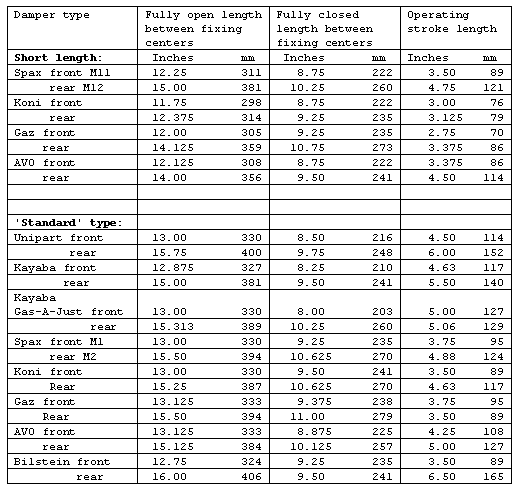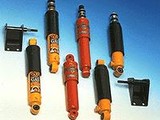Following the various articles I've done on suspension modifications and vehicle lowering, the most often asked question is 'do I need shortened shocks/dampers?'. This is impossible to answer confidently for all cars since lowering a car by a certain measurement is a relatively inaccurate description.
It all depends on what the car ride height was before lowering took place. Simply stating it was 'standard' is just as inaccurate - there are few Minis on the road today with the standard factory documented ride height. Largely brought about by the suspension settling/wearing in use and the rubber springs deteriorating over time. The official factory manual states a specific measurement from the center of the wheel hub to the top of the arch line. All well and good, but most folk effect their measurements from the sill line to the floor! Particularly where bodywork has been renovated and/or modified to take larger wheels and tyres.
Typically a 12" wheeled Mini is 9.75"/248mm from sill to floor and rear is 11.00"/279mm - measured at the sill ends immediately before the arch line/edge curves up. 10" wheeled Minis tend to be around 0.50"/13mm less at each end except for real early ones which are another 0.50"/13mm lower at the rear.
Whatever has or has not been done to your Mini by way on body repairs or modifications, the critical measurements as far as shocks/dampers fitment goes is the distance between the mounting points. These are easily measured with whatever shocks/dampers are on the car removed, car sat on a level-ish surface, and the rubber springs in place (the shocks/dampers do not influence the cars ride height). Simply measure the distance between the top and bottom from mounting pin centers and the rear lower mounting pin centre and underside of the arch where the top rear mounting pin locates. To assess which shocks/dampers you will need length-wise, select suitable shocks/dampers that will fit these dimensions and be in the middle of their stroke length. In fact, because a Mini has more droop than bump, the fitted length should be biased towards allowing more travel as the wheel droops than it does when compressing (over bumps). The more operational stroke length the shocks/dampers has, the more universal it's fitment. The less operational stroke it has - the more limited the wheel travel will be before trouble occurs.
The other key factor is knowing how much bump and droop travel occurs to avoid bottoming the shocks/dampers out. Allowing this to happen will irrevocably damage the fragile internal valving essential to the shocks/dampers performance. The Mini has surprisingly little over-all travel, barely 3"/76mm in total on the front of a road car and as much as 1.50"/38mm less on a racer with around 1"/25mm more at the rear. Most of that is in droop, probably 60%. So by way of a theoretical example to illustrate - typically 'as standard' the front shocks/dampers mounting pins are around 10.25"/260mm center to center.
Selecting a shocks/dampers to have this distance in the middle of its travel will require a shocks/dampers with an open length of no less than 11.75"/298mm and closed length of no more than 8.75"/222mm. Adding into this equation the allowance for the 60% in droop, this shuffles the figures to around 1.80"/46mm to the open and 1.20"/30mm to the closed lengths. So the new figures would be a shocks/dampers with 13.55"/344mm open length and 9.70"/246mm closed length.
From the table shown below - you can see that many of the performance shocks/dampers listed are very close to these limits with no margin for safety. In fact the only one that really covers all the bases is the Kayaba Gas-A-Just in the performance shocks/dampers arena. shocks/dampers with very little operational stroke will restrict wheel movement. Fine on a Formula 1 car, but has serious consequences on a Mini - like causing wheel spin to occur far earlier than normal. This reduces grip, drive and promotes under-steer. None of which improve cornering speeds at all! From this it can be seen that when lowering a Mini it is very advisable to fit the modified front shocks/dampers brackets that MSC/MME do (part number C-AJJ3359) to improve the shocks/dampers's lot.
TABLE OF shocks/dampers LENGTH COMPARISONS 
Useful part numbers:
552018 Kayaba Gas-A-Just gas pressurized mono-tube - front
552019 Kayaba Gas-A-Just gas pressurized mono-tube - rear
342001 Kayaba Up-grade standard gas shocks/dampers - front
342002 Kayaba Up-grade standard gas shocks/dampers - rear
442001 Kayaba standard replacement shocks/dampers - front
442002 Kayaba standard replacement shocks/dampers - rear
C-STR1675 Koni standard ride height adjustable shocks/dampers - front
C-STR1794 Koni standard ride height adjustable shocks/dampers - rear
C-STR1717 Koni lowered ride height adjustable shocks/dampers - front
C-STR1795 Koni lowered ride height adjustable shocks/dampers - rear
158-M1GAS Spax standard ride height 'knurled knob' adjustable shocks/dampers - front
158-M2GAS Spax standard ride height 'knurled knob' adjustable shocks/dampers - rear
158-M11GAS Spax lowered ride height 'knurled knob' adjustable shocks/dampers - front
158-M12GAS Spax lowered ride height 'knurled knob' adjustable shocks/dampers - rear
NGM1A Spax special softer rate adjustable for standard road use - front
NGM2A Spax special softer rate adjustable for standard road use - rear









